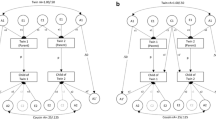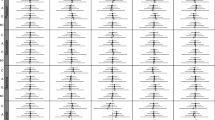Abstract
The linear structural model has provided the statistical backbone of the analysis of twin and family data for 25 years. A new generation of questions cannot easily be forced into the framework of current approaches to modeling and data analysis because they involve nonlinear processes. Maximizing the likelihood with respect to parameters of such nonlinear models is often cumbersome and does not yield easily to current numerical methods. The application of Markov Chain Monte Carlo (MCMC) methods to modeling the nonlinear effects of genes and environment in MZ and DZ twins is outlined. Nonlinear developmental change and genotype × environment interaction in the presence of genotype-environment correlation are explored in simulated twin data. The MCMC method recovers the simulated parameters and provides estimates of error and latent (missing) trait values. Possible limitations of MCMC methods are discussed. Further studies are necessary explore the value of an approach that could extend the horizons of research in developmental genetic epidemiology.
Similar content being viewed by others
References
Besag, J. E. (2000). Markov Chain Monte Carlo for Statistical Inference. Working Paper #9. Center for Statitics and Social Sciences, University of Washington, WA.
Besag, J. E., and Green, P. J. (1993). Spatial statistics and Bayesian computation (with Discussion). J. R. Stat. Soc. B 55: 25-37.
Brooks, S. P. (1998). Markov Chain Monte Carlo and its applications. Statistician 47: 69-100.
Burton, P. R., Tiller, K. J., Gurrin, L. C., Cookson, W. O. C. M., Musk, A. W., and Palmer, L. J. (1999). Genetic variance components analysis of binary phenotypes using generalized linear mixed models and Gibbs sampling. Genet. Epidemiol. 17: 118-140.
Clayton, D. G. (1999). Linear mixed models. In W. R. Gilks, S. Richardson, and D. Spielgelhalter (eds.), Markov Chain Monte Carlo in practice. London: Chapman and Hall.
Creutz, M. (1979). Confinement and the critical dimensionality of space-time. Physics Rev. Lett. 43: 553-556.
Do, K. A., Broom, B. M., Kuhnert, P., Duffy, D. L., Todorov, A. A., Treloar, S. A., and Martin, N. G. (2000). Genetic analysis of the age at menopause by using estimating equations and Bayesian random effects models. Stat. Med. 19: 1217-1235.
Eaves, L. J., Last, K. A., Young, P. A., and Martin, N. G. (1978). Model-fitting approaches to the analysis of human behavior. Heredity 41: 249-320.
Eaves, L. J., Martin, N. G., Heath, A. C., and Kendler, K. S. (1987) Testing genetic models for multiple symptoms: An application to the genetic analysis of liability to depression. Beh. Genet. 17: 331-341.
Fulker, D. W. (1973). A biometrical genetic approach to intelligence and schizophrenia. Soc. Biol. 20: 266-275.
Gelfand, A. E., and Smith, A. M. F. (1990). Sampling based approaches to calculating marginal densities. J. Am. Stat. Assoc. 85: 398-409.
Gelman, A., Carlin, J. B., Stern, H. S., and Rubin, D. B. (1995). Bayesian data analysis. New York: Chapman and Hall.
Geman, S., and Geman, D. (1984). Stochastic relaxation, Gibbs distributions and the Bayesian restoration of images. Inst. Electrical Electronics Eng. Trans. Pattern Analysis Machine Intelligence 6: 721-741.
Gilks, W. R., Richardson, S., and Spielgelhalter, D. (1996). Markov Chain Monte Carlo in practice. London: Chapman and Hall.
Hastings, W. K. (1970). Monte Carlo sampling methods using Markov chains and their applications. Biometrika 57: 97-109.
Jinks, J. L., and Fulker, D. W. (1970). Comparison of the biometrical genetical, MAVA and classical approaches to the analysis of human behavior. Psychol. Bull. 73: 311-349.
Lindstrom, M. J., and Bates, D. M. (1990). Nonlinear mixed effects models for repeated measures data. Biometrics 46: 673-687.
Martin, N. G., and Eaves, L. J. (1977). The genetical analysis of covariance structure. Heredity 38: 79-95.
Metropolis, N., Rosenbluth, A., Rosenbluth, M., Teller, A., and Teller, E. (1953). Equations of state calculations by fast computing machines. J. Chem. Physics 21: 1087-1091.
Meyer, J. M., and Eaves, L. J. (1988). Estimating genetic parameters of survival distributions. Genet. Epidemiol. 5: 265-275.
Meyer, J. M., Eaves, L. J., Heath, A. C., and Martin, N. G. (1991). Estimating genetic influences on age at menarche: a survival analysis approach. Am. J. Med. Genet. 39: 148-154.
Molenaar, P. C. M., Boomsmas, D. I., Neeleman, D., and Dolan, C. V. (1990). Using factor scores to detect G × E interactive origin of ‘pure’ genetic or environmental factors obtained in genetic covariance structure analysis. Genet. Epidemiol. 7: 83-100.
Neale, M. C., Boker, S. M., Xie, G., and Maes, H. H. (1999). Mx: Statistical modeling. 5th ed. Department of Psychiatry. Box 126 VCU, Richmond, VA 23298.
Neale, M. C., and Kendler, K. S. (1995). Models of comorbidity for multifactorial disorders. Am. J. Hum. Genet. 57: 935-953.
Ripley, B. D. (1979). Algorithm AS 137: Simulating spatial patterns: Dependent samples from a multivariate density. Appl. Statist. 28: 109-112.
Shoemaker, J. S., Painter, I. S., and Weir, B. S. (1999). Bayesian statistics in genetics—a guide for the uninitiated. Trends Genet. 15: 354-358.
Sivia, D. S. (1996). Data analysis: a bayesian tutorial. Oxford: Oxford University Press.
Spielgelhalter, D. J., Thomas, A., and Best, N. G. (1999). WinBugs version 1.2 User Manual. Cambridge: MRC Biostatistics Unit.
Spiegelhalter, D. J., Best, N. G., Carlin, B. P., and van der Linde, A. (2002). Bayesian measures of model complexity and fit. J. R. Stat. Soc. Ser. B 64: 1-34.
Thomas and Gauderman (1996). Gibbs sampling methods in genetics. W. R. Gilks, S. Richardson, and D. Spielgelhalter (eds.), In Markov Chain Monte Carlo in Practice. London: Chapman and Hall.
Tierney, L. (1994). Markov chains for exploring posterior distributions (with Discussion). Ann. Stat. 22: 1701-1762.
Zeger, S. L., and Karim, M. R. (1991). Generalized linear models with random effects: A Gibbs sampling approach. J. Am. Stat. Assoc. 86: 79-86.
Rights and permissions
About this article
Cite this article
Eaves, L., Erkanli, A. Markov Chain Monte Carlo Approaches to Analysis of Genetic and Environmental Components of Human Developmental Change and G × E Interaction. Behav Genet 33, 279–299 (2003). https://doi.org/10.1023/A:1023446524917
Issue Date:
DOI: https://doi.org/10.1023/A:1023446524917




